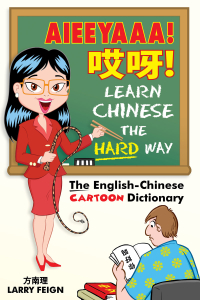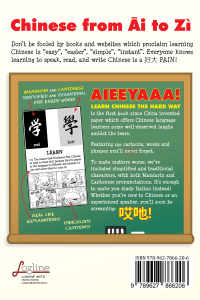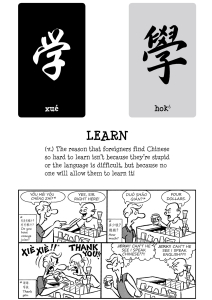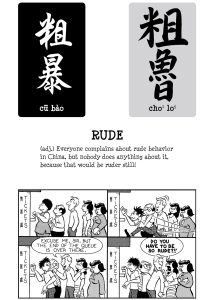It all started with a sex-crazed American expat asking an unsuspecting Hong Kong woman to strip. Well, kind of. Cartoonist Larry Feign had just moved to Hong Kong, and he and his wife, Cathy, were in the kitchen cooking. Feign asked her in Cantonese if she wanted some “choi sum” (a small Chinese cabbage) but mispronounced it as “chui saam.” Cathy stared at him and explained, “You just told me to get undressed!” That was a light-bulb moment for Feign as to the “unending potential for bilingual puns and humour with Cantonese and English.” The World of Lily Wong was born, a much loved daily comic strip in the South China Morning Post chronicling the adventures of a young local woman, her family, and a bumbling foreigner. It poked fun at both the materialistic, gambling-obsessed locals and the expatriates with their sense of entitlement and lack of language skills. Humorous observations of everyday life in Hong Kong sometimes gave way to darker cartoons with a political edge, and these ultimately cost Feign his job.
In 1995, following a series of cartoons about China’s alleged trade in the bodily organs of executed prisoners, The World of Lily Wong was suddenly discontinued. Despite denials from the paper, Feign’s dismissal was seen as an obvious case of self-censorship in the sensitive lead-up to the 1997 handover of the British colony, and it made headlines around the world. The comic strip, which had first appeared in 1986, was picked up by other newspapers, and last ran as a regular strip in 2001.
Feign has returned to the language aspect of his humour with a wonderful new edition of cartoons packaged satirically as a dictionary. The title Aieeyaaa! loosely translates from Cantonese as, “Oh, no!” but can express a wide range of emotions. The subtitle, Learn Chinese the Hard Way is a much-deserved mockery of books promising magic shortcuts to mastering the language. Unfortunately, these shams seem to generate publicity in inverse proportion to their usefulness, the most recent example of this being the oxymoronic (and just plain moronic) Chineasy.
AIEEYAAA! Learn Chinese the Hard Way features 149 cartoons about life, love, and work, with a focus on linguistic mix-ups and the clash of cultures between East and West. Each page features a “dictionary” entry in English, one or more drawings, a definition, and two sets of translations: Mandarin in simplified characters with Hanyu Pinyin, and the traditional characters with romanized Cantonese.
The cartoons are well drawn and the ratio of laughs to non-laughs high, not surprising given that the book is in some ways a “best of” collection. This has a downside though. While Feign has obviously not included cartoons with obsolete references, the drawings can as a whole seem a bit dated. It’s not the clothes, the hairstyles, cars, or the topics covered, but the absence of two things. Firstly, smartphones; so ubiquitous are these accursed devices today that any crowd scene – whether in a shop, restaurant, street, well, anywhere – seems oddly quaint if free of screen-fixated zombies. The other omission that stands out is the influx of visitors and migrants from China, and the local reactions to this.
The book’s mock dictionary definitions are funny; “herbal medicine” is described as, “Potions which cure any illness by tasting so incredibly vile that your body heals itself just to avoid being subjected to a further dose;” and sometimes the definitions offer perceptive insights such as for the “marriage” entry, “Union between a man and the other woman in his life.” The drawings show a crying woman complaining, “Married only two years and already you’re starting to spend time with another woman!” The man responds, “Who are you talking about?” to which the woman answers, Your wife!” This perfectly captures a Chinese mother’s often domineering role in a man’s life.
The cartoon for “cousin” highlights the inexactness of some English words for describing family relationships. Unlike the one-size-fits-all “cousin,” the multiple Chinese equivalents tell you if the said person is male or female, on the mother’s or father’s side, older or younger than the speaker.
Cantonese and Mandarin are mutually incomprehensible languages rather than dialects, though they do share the feature of being very challenging. Of Cantonese Feign says it “sometimes feels like it was designed by a committee for the sole purpose of being impossible for foreigners to learn.” Indeed, if you thought Mandarin was bad with its four tones (five if you count the “neutral” tone), Cantonese is even worse with its six tones (or nine according to some linguists). Romanization is more problematic, too, with no standard system such as with Hanyu Pinyin for Mandarin. Feign’s book uses the Sydney Lau system with the tone indicated by a small number, 1 through 6, placed upper-right of the word.
The inclusion of Cantonese in AIEEYAAA! makes this book a useful resource for residents of Hong Kong and Guangzhou, but it also has a broader appeal. Cantonese has played an important role in the West’s interaction with China, and Cantonese words are often as familiar as their Mandarin counterparts. Take, for example, the “saam” (clothes) in the earlier mentioned “chui saam” (remove clothes) which you will have heard in “cheongsam” (lit. long clothes). In Mandarin the tight-fitting silk dress is called a “qipao.” Western contact with early Qing-dynasty China was largely restricted to the southern city of Canton (Guangdong), so many of the words that we think of as Chinese are, in fact, of Cantonese origin. Some culinary examples include chop suey, kumquat, wok, and dim sum, which is featured in the book, (from Cantonese “dim sam:” in Mandarin, “dianxin”).
One of the threads of humour in Learn Chinese the Hard Way is misunderstandings from homophones (words that sound the same) and mispronunciation. One of the cartoons makes fun of “buy” and “sell” sounding so similar. In Chinese both are “mai,” the former third tone and the latter fourth tone. Funny linguistic mix-ups are sometimes more than the well-worn jokes used by language teachers; they really happen and have real-life consequences. Feign gives a great example in the introduction. Instructing a contractor in Cantonese to separate two rooms with a long wall “cheung” (fourth tone) he ended up with a huge window, cheung (first tone).
Although Feign has a disclaimer that this is not a real language book, but rather “a random assortment of words with gags attached,” you will definitely learn something. Feign says he picked up Cantonese through a similar piecemeal approach. Because of the interesting delivery, the content of the cartoons tends to stick with you. I can recall cartoons from The World of Lily Wong that I last read more than a dozen years ago.
Some of the dictionary entries offer practical cultural insights, things often learned the hard way by newcomers. There’s “three” (“san” in Chinese and “saam” in Cantonese – yes, pronounced like “saam” for clothes, and even with the same first tone. Aieeyaaa!). Feign explains “three” is the “Number of times you have to ask before a Chinese person will tell you what you suspected in the first place.” Likewise, “try my best” (ke jin / jun leung) is “The ubiquitous response to any request, which actually means, “I’ll do nothing of the sort.”
Anyone who has spent time in East Asia should enjoy AIEEYAAA! Learn Chinese the Hard Way. Cartoons are an ideal medium for the stumbling word-sparse interactions of colliding cultures, and when it comes to this art form, Master Feign’s kung fu is strong. His good-natured yet revealing humour makes for a fun read and some coincidental pain-free language acquisition. Rather than ending this review with my recommendation, I will do so with a more telling one – the popularity of his cartoons among the local non-expat population of Hong Kong. Feign’s readership has always been predominantly bilingual locals, and the bulk of his fan mail is from them. He has won awards, including one for cartoons run in the Chinese-language press. It says a lot about the Feign’s accuracy, fair-mindedness, and wit.
To learn more about the book and author, visit: www.larryfeign.com/aieeyaaa
To buy the book from Amazon.




